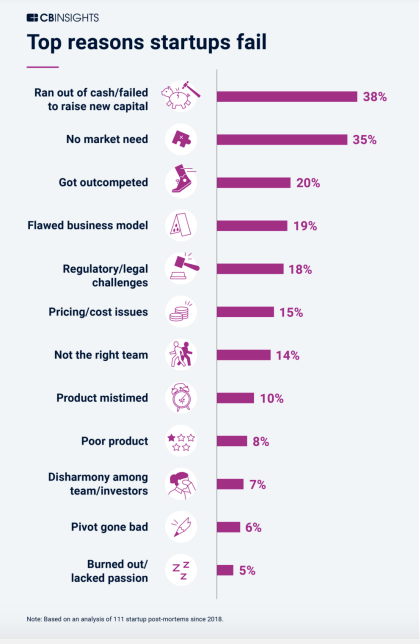Flying High in the Face of Failure: The Right Way to Innovate
12.5 minutes

Innovation is nothing new.
We have been planning, developing, launching, and improving new products, services, and businesses since the dawn of mankind. From Stone Age tools to the AI tech that will power our future robot masters*, innovation has been the driving force behind our progress as a species.
* Don’t let those “Robot Fights Back” videos fool you: first, they’re fake; second, science says AI uprisings are highly unlikely.

Photo by Rock’n Roll Monkey on Unsplash
Innovation is one of the pillars of business growth
In any context, innovation is much more than simply developing or implementing a new tool or process. The fundamental goal of every innovation is the creation of “options for future growth”1. Stone Age tools improved our ancestors’ ability to build, hunt, and create. The benefits of today’s machine learning business applications include increased efficiency, greater cost savings, and better customer experiences — all of which make significant contributions to business growth.
It’s important to note that innovation does not mean a product or service that is unlike any other. Just look at Google — when it comes to, say, search engines, email clients, and browsers, we were content to use other highly capable services. Google did not reinvent the virtual wheel; they innovated online experiences, then brought the same logic to hardware products like smartphones, laptops, and smart home devices. We could say the same about big players like Amazon, Apple, and Facebook.
Speaking of Facebook, they entered the hardware market with their own innovations years ago. If this is the first time you are hearing about this, that’s not surprising, as their efforts have not been very fruitful. However, the social media giant’s difficulty in capturing a respectable share of the hardware market has not stopped it from continuously innovating. Clearly Facebook and other successful companies understand that every failure (we’re looking at you, Google Glass) is a learning experience they can leverage to promote business growth.
The giants of Silicon Valley, like the startups clawing at their heels, foster cultures of innovation. Indeed, it was Steve Jobs who provided one of the most popular definitions of the term. “Innovation,” Jobs said, “is the ability to see change as an opportunity, not a threat.”2
Why corporate innovation fails
Since innovation comes in many forms, so too does innovation failure. Sometimes it can arise from external factors like bad timing or changing consumer trends. More often, the key source of failure comes from within an organization itself.
In 2021, market research firm CB Insights analyzed 111 failed startups to determine the most common reasons for their lack of success3. Since startups are, almost by definition, hubs of ideation and innovation, the resulting report can help us frame how to think productively about innovation failure in general. The top three reasons the surveyed businesses sank were:
- insufficient capital (38%)
- lack of market need (35%)
- inability to keep up with the competition (20%).
Flawed business models, regulatory issues, mistimed product launches, and disharmony among stakeholders also featured prominently on the list.

At first glance, these causes of failure may seem too disparate to draw useful lessons from. In fact, there are a few common threads running through them, in particular inadequate resources and unclear go-to-market strategies.
Innovation is about more than just creating ideas. It is an end-to-end process that runs from ideation to execution, encompassing a variety of practical activities. Smart resource allocation, therefore, is crucial if you are going to turn an idea into something commercially viable. The same goes for having a robust business strategy. Blockbuster Video presents an interesting case in point.

The infamous ‘Last Blockbuster’ in Bend, Oregon
At its height, Blockbuster presided over a video rental empire of more than 9,000 stores. In 2022, the company is a shadow of its former self, operating just one store in Bend, Oregon. The standard narrative of Blockbuster’s decline typically focuses on the rise of on-demand streaming in general, and Netflix in particular. However, Blockbuster’s leadership team was all-too-aware in the early 2000s that consumer trends were moving in a direction that favored the likes of Netflix. Indeed, the company already enjoyed a growing digital business by the time Netflix arrived on the scene. Crucially, though, it had also inherited more than a billion dollars in debt – and this massively constrained its ability to pivot successfully when brick-and-mortar rental stores began to go out of fashion. As a result, Netflix is a cultural icon worth hundreds of billions of dollars, while Blockbuster is practically synonymous with innovation failure.4
How to drive innovation to success
1. Know your value proposition and product-market fit
A value proposition is a statement that identifies the benefits your customer will get from buying your product. By articulating these benefits in a clear and measurable way, you can laser-focus on where the true value of your innovation lies from day one — and avoid getting caught up in the inessential details. A good value proposition may take any number of forms, but it will always answer the following questions:
- Who are my potential customers?
- Where can I find them?
- What specific problem does my innovation solve?
- Is the market big enough to justify the project?
Once you have a strong understanding of your market, you can begin to establish your product-market fit. In the words of venture capitalist Marc Andreessen, who coined the term in an influential blog post5, product-market fit simply means “being in a good market with a product that can satisfy that market.” The search for product-market fit leaves little room for sentimentality: it will require an experimental mindset and a readiness to pivot if the need arises. At this stage of your product’s lifecycle, you should treat every interaction you have with a potential customer as data to be parsed. All this data should be directed towards solving the problem you have identified in the research phase.
After you have market-verified your value proposition, the next step in your innovation journey will be to rigorously define the product. Bear this chronology in mind: the second most common cause of startup failure according to the CB Insights report cited above was a lack of market need. In other words, know your market, then know your product.
2. Define your product
During the product definition stage, your innovation should begin looking more and more like a real, commercially-viable product. This is when you cast aside all the vague potential things your idea could be and ruthlessly identify the one thing it has to be.
- Create an identity. This means choosing names, logos, color schemes, and early advertising content.
- Explore marketing strategies. You already know how brilliant and useful your innovation is. Now it’s time to tell your customers too.
- Build your team. Early employees have a profound effect on the identity and culture of a company, and on whether it floats or sinks. Your initial team should have as strong a grasp of your product’s potential, and be as excited about it, as you are.
- Understand pricing. As your innovation moves from idea to product, you can now consider the best pricing strategy. Whether you choose a subscription or one-off payment model, a budget or a premium price, will depend entirely on the market your product is serving.
3. Launch your minimum viable product
Your minimum viable product, or MVP, is the earliest version of your product that customers can actually use to solve their problem. As you progress towards the launch date, you should choose the technology that underpins your MVP. You will need the right programming language, development tools, and infrastructure. You may want a cloud or dedicated server, depending on your needs (more on that here). Of course, you’ll also need the right team, including platform-specific developers with enough experience. If this is too much of a challenge, then it might be time to work with an external agency as you build out the tech.
Next, you must calculate your customer lifetime value (CLV) – i.e. the value of a given customer over the duration of their relationship with your business. This will likely take an improvised, back-of-the-napkin form at first. Once real customer data starts coming in, you can adjust your expectations accordingly. Above all, you must ensure that your CLV is higher than the costs associated with acquiring customers in the first place. Serial entrepreneur David Skok identifies high customer acquisition costs as the second biggest “startup killer” after poor product-market fit6. According to Skok, enthusiastic innovators often “grossly underestimate the cost it will take to acquire customers” and end up paying for it with the future of their business. Avoid this trap.
4. Don’t stop iterating
With an early version of your product now on the market, you can now move to the “final” stage in the innovation process: iteration. This stage typically involves making product modifications based on early customer feedback. It’s also when you can start thinking seriously about the costs and logistics of scale. As always, the conclusions you come to should be grounded in genuine data, not unsupported assumptions. The more data you acquire, the smarter your process will be as you turn your MVP into a fully-fledged consumer product.
How can U+ help your company become a leader in innovation?
The U+ Method can successfully lead the development, implementation, and improvement of digital innovations in any industry, from fintech through automotive to healthcare. U+ takes a sector-agnostic approach to innovation; specific products and markets matter less than the high-level process of taking a business somewhere new.
To date, we have used this method to bring more than 90 innovative products to market, creating over $1 billion in value for Fortune 1000 companies.
1Kupp & Kromer, Kromatic, Innovation Portfolio Management
2Carmine Gallo, Forbes, The 7 Innovation Secrets of Steve Jobs
3CB Insights, The Top 12 Reasons Startups Fail
4Luca Piacentini, 1851 Franchise, The Real Reason Blockbuster Failed
5Marc Andreessen, Pmarca, Guide to Startups Part 4
6David Skok, For Entrepreneurs, Startup Killer: The Cost of Customer Acquisition
